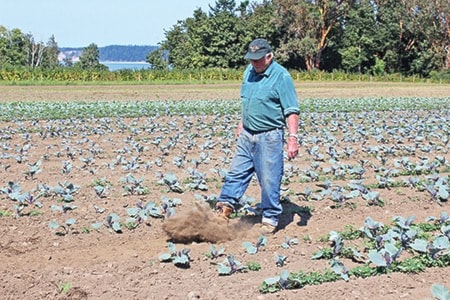By Carlie Connolly/News staff
Vern Michell of Michell Brothers Farm in Central Saanich says this year’s drought has been the worst he’s seen.
With around 400 acres of land and a wide variety of crops, Mitchell said the extended period of heat has caused his farm problems.
“This is the worst year that I can remember for drought and heat, and that’s a lot of years,” he said.
With the Peninsula getting only 40 per cent of its usual precipitation from April to July, the Michells have had to supply the rest of what their crops need with their own irrigation.
“This year we had to supply 100 per cent of the moisture to keep these plants growing. It’s added a big cost to us, with running these sprinklers 24 hours a day ... and somebody to do the work with irrigating,” he said.
With the crops they’ve harvested to date, Michell said he thinks it has added around 30 per cent more to their cost of growing vegetables and fruit — that cash cutting into their profits.
He said when the water is turned on, it takes only about two days for it to completely evaporate, meaning they have to water more often. Because of this, Michell said its added a lot to the cost of just watering alone.
As for the impact on their crops, some of their fruit (strawberries/raspberries) were turned to jam as a result of the heat.
Pumpkins and squash, which are very early this year, don’t need rain, he explained, and the hot sun hardens the shell of the pumpkins and might be good until Halloween.
Michell said hay has also been affected negatively. The first cut of hay, which starts growing in February and March, was pretty normal.
He added they hope for a second cut, watering and fertilizing it many times. Because there has been little to no rain, their second cut hay was about 50 per cent of the size of a normal crop. And Michell said that represents a large loss. This means they are charging a little more for their hay, he said, which could lead to an increase in prices for this fall and winter.
For their own cows, he noted his operation is trying to salvage every little bit of hay they can, feeding them some vegetable leaves to make up for some of the losses in the second cut of hay.
Michell said the heat has also contributed to an increase in the population of bugs like aphids and mites that thrive on dead grass. The aphids have been a problem, but Michell said he is fending infestation off by trying to use more water and wash them off the plants.
“So at the same time we are controlling the bugs as well as watering our plants,” he said.
Despite these extra costs and losses of some fruit, Michell said some farmers can absorb the initial losses. However, he added consumers of local produce will see some hefty price increases. Even so, he said he recommends people should still try to buy local, freeze, dry and can the food for fall and winter. Because some of these crops are so early, he said, they will be finished soon.
